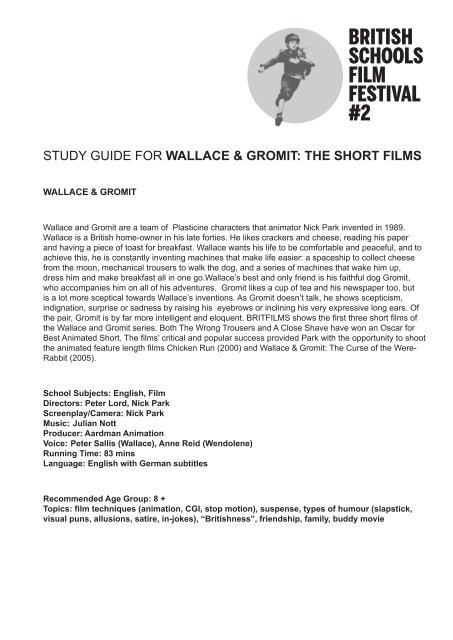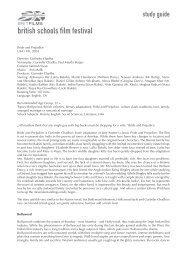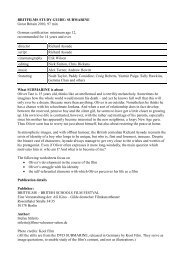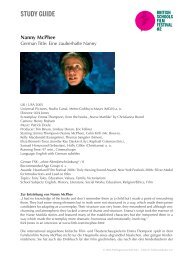BRITISH SCHOOLS FILM FESTIVAL #2 - AG Kino
BRITISH SCHOOLS FILM FESTIVAL #2 - AG Kino
BRITISH SCHOOLS FILM FESTIVAL #2 - AG Kino
Create successful ePaper yourself
Turn your PDF publications into a flip-book with our unique Google optimized e-Paper software.
<strong>BRITISH</strong><br />
<strong>SCHOOLS</strong><br />
<strong>FILM</strong><br />
<strong>FESTIVAL</strong><br />
<strong>#2</strong><br />
Study Guide for WALLACE & GROMIT: THE SHORT <strong>FILM</strong>S<br />
WALLACE & GROMIT<br />
Wallace and Gromit are a team of Plasticine characters that animator Nick Park invented in 1989.<br />
Wallace is a British home-owner in his late forties. He likes crackers and cheese, reading his paper<br />
and having a piece of toast for breakfast. Wallace wants his life to be comfortable and peaceful, and to<br />
achieve this, he is constantly inventing machines that make life easier: a spaceship to collect cheese<br />
from the moon, mechanical trousers to walk the dog, and a series of machines that wake him up,<br />
dress him and make breakfast all in one go.Wallace’s best and only friend is his faithful dog Gromit,<br />
who accompanies him on all of his adventures. Gromit likes a cup of tea and his newspaper too, but<br />
is a lot more sceptical towards Wallace’s inventions. As Gromit doesn’t talk, he shows scepticism,<br />
indignation, surprise or sadness by raising his eyebrows or inclining his very expressive long ears. Of<br />
the pair, Gromit is by far more intelligent and eloquent. BRIT<strong>FILM</strong>S shows the first three short films of<br />
the Wallace and Gromit series. Both The Wrong Trousers and A Close Shave have won an Oscar for<br />
Best Animated Short. The films’ critical and popular success provided Park with the opportunity to shoot<br />
the animated feature length films Chicken Run (2000) and Wallace & Gromit: The Curse of the Were-<br />
Rabbit (2005).<br />
School Subjects: English, Film<br />
Directors: Peter Lord, Nick Park<br />
Screenplay/Camera: Nick Park<br />
Music: Julian Nott<br />
Producer: Aardman Animation<br />
Voice: Peter Sallis (Wallace), Anne Reid (Wendolene)<br />
Running Time: 83 mins<br />
Language: English with German subtitles<br />
Recommended Age Group: 8 +<br />
Topics: film techniques (animation, CGI, stop motion), suspense, types of humour (slapstick,<br />
visual puns, allusions, satire, in-jokes), “Britishness”, friendship, family, buddy movie
THE SHORT <strong>FILM</strong>S:<br />
Wallace & Gromit: A Grand Day Out<br />
UK, 1989<br />
Wallace has a problem. There is no cheese in the house and the shops are closed for holiday.<br />
Wallace has to find a way to get some of his favourite food. He suddenly remembers that the<br />
moon, as everyone knows, is made of cheese, and decides to build a rocket for a trip to the<br />
moon. With the help of faithful and clever Gromit, he succeeds and lands on the moon. Their<br />
picnic, however, is to be disturbed by a very strange inhabitant: a policing oven who dreams of<br />
skiing.<br />
Wallace & Gromit: The Wrong Trousers<br />
UK, 1993<br />
On his birthday, Gromit gets a pair of techno-trousers from Wallace. The idea (that Gromit<br />
does not like at all) is that the trousers take him for his walkies while Wallace is busy solving<br />
their financial problems. Gromit is even more disgusted when Wallace decides to let his room<br />
to a stranger. The new lodger, who turns out to be an escaped criminal penguin, worms his<br />
way into Wallace’s heart and succeeds in driving Gromit away. However, when the penguin<br />
gets Wallace and the techno-trousers involved in a thrilling crime, Gromit returns to help.<br />
Wallace & Gromit: A Close Shave<br />
UK, 1995<br />
In this action-packed sequel, Wallace and Gromit work as window cleaners. One day they<br />
clean windows for wool-shop owner Wendolene Ramsbottom. To Gromit’s dismay, Wallace<br />
immediately falls in love with the sweet lady. What he doesn’t know is that Wendolene’s nasty<br />
dog Preston is secretly stealing sheep and turning them into dog food. When their new little<br />
friend Shaun the sheep is threatened and Gromit is mistakenly arrested by the police as the<br />
wanted sheep rustler, Wallace has to act.
Best Buddies<br />
The Wallace & Gromit short films, especially The Wrong Trousers, work a lot with generic<br />
formulae. Genres offer director and audience a safe framework of what to expect from a<br />
movie. In a Western, for example, there will be cowboys, saloons, shoot-outs, horses and<br />
beautifully shot landscapes. The hero will accept his mission and succeed in avenging evil.<br />
He may or may not perish in the attempt. At the same time, the rules of genre can be bent to<br />
great effect as long as the genre as such remains recognisable. The director may disappoint<br />
and play with the expectations of the audience to amuse, shock or make a point. In The Wrong<br />
Trousers, for example, the discrepancy between the cute plasticine figures and the thrilling plot<br />
is a constant source of amusement.<br />
At their heart, the Wallace & Gromit films are buddy movies. As with Laurel and Hardy or<br />
Asterix and Obelix, there is one protagonist who is smarter than the other (Gromit) and has to<br />
counterbalance his partner’s mishaps. His partner (Wallace) on the other hand, is the driving<br />
force of the action: he decides to take a trip, he invents things, he falls in love.<br />
During their adventures together the partners’ different characters usually clash to comic<br />
and dramatic effect. Conflict threatens to divide them. They will go through feelings of<br />
estrangement, sadness, jealousy, anger, disappointment and loss. In the end, however,<br />
harmony will be restored and the heroes will have learned again to trust each other and to<br />
appreciate their differences.<br />
With Wallace and Gromit, it is usually Wallace who gets things going when he decides to<br />
visit the moon, invites the penguin into the house or falls in love with Gwendolene. In his<br />
enthusiasm he more than once overlooks Wallace’s needs and tramples over his feelings.<br />
Gromit faithfully cooperates, but at the same time his eyebrows keep up a constant<br />
commentary on Wallace’s inadequacies. However, when things get tight, the friends stick<br />
together and at the end of the day Wallace knows very well that Gromit is his best buddy.<br />
Suspense and Melodrama<br />
The Wallace & Gromit films also borrow numerous elements from thriller, horror, caper and<br />
action movies. Various allusions to these genres are made, for example, in the style of the<br />
title, type of music, film noir camera angles, and arrangement of scenes. Both The Wrong<br />
Trousers and A Close Shave showcase spectacular chase sequences reminiscent of the<br />
James Bond series. In The Wrong Trousers, Wallace and Gromit chase the penguin on top<br />
of a model train and in A Close Shave, the chase sequence involves a whole troupe of sheep<br />
performing acrobatics on top of a car.<br />
The Wrong Trousers also contains an extended spoof of heist movies. In a heist movie the plot<br />
mainly revolves around the planning and carrying out of a robbery or some other criminal act.<br />
The comic version of this genre is called a caper film. Examples for caper movies are Ocean’s<br />
Eleven, The Pink Panther, Snatch and The Olsen Gang.<br />
Some of Park’s other favorite cinematic means are taken from horror movies, such as the<br />
chilling soundtrack of A Grand Day Out, which features creeky stairs, dripping water and the<br />
ticking of time running out. The camera is often positioned at extreme angles, showing the<br />
action from far below or above or through key holes. In several instances we see the villain‘s<br />
shadow before we meet the actual figure. The lighting in those scenes tends towards dark<br />
blue and the music further enhances a sense of foreboding and danger. In especially dramatic<br />
moments, such as when Gromit decides to leave Wallace, sound, lighting, colour and even the<br />
weather are used in melodramatic tradition to underline the desperate mood of the lonesome<br />
dog.
Park uses these quotes and techniques mostly for comic effect, but at the same time they work<br />
as intended and create suspense, fear and sympathy for the plight of the heroes. They also<br />
betray Park’s deep love for the „magic“ of cinema:<br />
“I think I‘ve always had a strong memory of what I loved as a child, the kinds of things I grew<br />
up with and the atmospheres in films I loved. The magic evoked by films in the music or the<br />
lighting and the stories. […] But I was also inspired by all sorts of films, especially thrillers, and<br />
a lot of Hitchcock; I saw The Birds as a child and it inspired me.”<br />
(http://film.guardian.co.uk/oscars2006/story/0,,1699886,00.html)<br />
Humour: Slapstick, Allusion, Visual Puns, In-Jokes and the “small quirky Britishness”<br />
Although animated films are usually associated with children, the Wallace & Gromit films have<br />
always succeeded in appealing to a wider audience. While children relate to the cute/funny<br />
characters, the slapstick humour and action, the more experienced viewer enjoys the hidden<br />
puns that are often found in the small details of the film. Park likes to satirize different genres<br />
of film and literature, he frequently includes references to former episodes or other works of<br />
fiction, he enjoys visual puns and he likes to play around with British stereotypes that he calls<br />
“small quirky Britishness”. In-jokes and allusions add a layer of interest and form a secret<br />
connection between the director and a viewer who shares the same cultural knowledge.<br />
Slapstick: The Wallace & Gromit series relies heavily on physical humour. Slapstick<br />
scenes involve the sawing-off of the legs of the table Wallace sits on, getting splattered with<br />
marmalade and blow-drying Wallace’s large ears.<br />
Literary references and word games: Gromit’s books are deserving of a closer look: “Crime<br />
and Punishment” by Fido Dogstoyevski, “The Republic” by Pluto, “Men are from Mars and<br />
Dogs are from Pluto”.<br />
Cinematic allusions: Generic elements are used, such as the chase, the shadow of<br />
the intruder, the view through the peephole, and the shoot out. Gromit’s graduation from<br />
“Dogwarts University”, of course refers to “Hogwarts School of Witchcraft and Wizardry”.<br />
In-jokes: The wallpaper in The Wrong Trousers shows the spaceship built by Wallace and<br />
Gromit in A Grand Day Out. One of the newspaper headlines says “Moon Cheese Shares<br />
Sour”, another “Dog reads paper”.<br />
Visual puns: Wallace hides his piggy bank behind the picture of a piggy bank. When the evil<br />
penguin moves in he exchanges Gromit’s bone-patterned wallpaper for a wallpaper patterned<br />
with fish. When the penguin commits criminal acts he disguises himself as a chicken.<br />
Puns on British conventions: Wallace and Gromit live in a typical semi-detached house<br />
featuring fireplaces, toast, knitted jumpers and ornamental wallpapers. They like their cup of<br />
tea and their daily paper (Morning, Afternoon and Evening Paper). References are made to the<br />
very British Wensleydale and Stilton cheeses.<br />
Sound and music: Sound and music are also used for comic effect. The score and<br />
soundtracks often imitate the exaggerated orchestral style of 1950s suspense and melodrama<br />
movies. There are also instances of the so-called Mickey Mousing technique, which means<br />
that sound is acoustically mimicking an action or movement. The technique is often used in<br />
slapstick or animation films.
Animation<br />
Despite the advances in animation technology, the Wallace & Gromit films are made almost<br />
completely without computer generated animation (CGI). Some effects, however, cannot be<br />
created with stop-motion, such as the scenes where soap, porridge, or smoke are involved.<br />
In those cases CGI is used. For Park, working completely with hand-made Plasticine figures<br />
has both practical as well as ideological reasons:<br />
“Plasticine was available when I was a teenager and started doing animation. I wanted to be like<br />
Disney, trying to film with plastic cels, but it was all too expensive. I didn’t have enough money<br />
to buy cels, at least not enough to make more than four-and-half seconds of animation. But<br />
Plasticine was around, user-friendly and available to the masses. It was great because all you<br />
needed was camera, an Anglepoise lamp and a table. And you would make whatever you like<br />
come out of a blob of Plasticine.[…] I fundamentally like drawing cartoons really and that’s gone<br />
into Plasticine form. But there’s something I like about just making characters out of clay.”<br />
(http://film.guardian.co.uk/oscars2006/story/0,,1699886,00.html [09/2007])<br />
The basic principle behind classical animation is the stop-motion, or frame-by-frame<br />
technique that turns a static object into a moving object. Stop-motion is based on the principle<br />
of a flip book. An object or image is photographed, then changed a tiny bit, than photographed<br />
again. When the single images are shown as a continous sequence at the rate of 24 images<br />
per second or even less, the human mind perceives a continuous motion.<br />
Traditional hand-drawn animation uses cels, short for celluloid. Characters, objects, and<br />
backbround motifs can be drawn on these transparent sheets and thus allow the filmmaker to<br />
repeat parts of the drawing e.g. a static background behind a moving character. The classic<br />
Disney animations such as The Jungle Book or 101 Dalmations are examples of 2D animation.<br />
Model animation has been part of film for a long time. It is based on the same principle<br />
as cartoon animation, only that it works with real objects instead of drawings. The Wallace<br />
& Gromit series grows out of a largely European tradition of short stop-motion films made<br />
by individual artists and stop-motion series made principally for children’s television. Some<br />
famous animators working in this tradition are the Czech surrealist Jan Svankmajer, the Quay<br />
Brothers or Tim Burton. In 1978, American filmmaker Will Vinton coined the term Claymation®,<br />
combining the words clay and animation. The term means animation with clay figures (or<br />
similar pliable material as Plasticine) that are usually sculpted around a wire skeleton called an<br />
“armature”.<br />
The second, predominantly Hollywood tradition is the „invisible“ history of stop-motion<br />
animation as a branch of special effects for feature-length films. A famous early example<br />
of model animation as part of a film is King Kong from 1933. 3D animation was introduced<br />
through pure object animation to the audience, but was partially replaced in the 1970s, and<br />
then totally substituted for by computer generated images (CGI). With CGI a filmmaker<br />
does not need to construct miniatures for effects, move puppets by hand or hire extra people<br />
for crowd scenes. Thus, a single artist can produce content without actors, expensive set<br />
pieces, or props. It allows the creation of images that would not be feasible using any other<br />
technology. An early example of CGI would be the Star Wars episode from 1977 with its Death<br />
Star simulation. With its dinosaurs, Jurassic Park (1993) presented the first photo-realistic<br />
animals, and the Lord-of-the-Rings trilogy (2001, 2002, 2003) features CGI creature Gollum.<br />
In mid-November 2007, Robert Zemeckis’ CGI-project Beowulf is going to be released in<br />
Germany, starring the digital counterparts of Angelina Jolie, Anthony Hopkins, Robin Wright<br />
Penn, and John Malkovich.
Useful Links:<br />
Animation Film<br />
http://www.filmreference.com/encyclopedia/Academy-Awards-Crime-Films/Animation-3D-<br />
STOP-MOTION-ANIMATION.html:The history of 3D stop motion animation.<br />
http://www.aardman.com/html/history.asp: The history of the Aardman production company<br />
http://www.wallaceandgromit.com : Wallace & Gromit’s official website.<br />
http://www.atomfilms.com/film/creature_comforts.jsp : Nick Park’s five-minute short film<br />
Creature Comforts can be seen in full length.<br />
http://www.willvinton.net : The history of Vinton’s work in animation film.<br />
http://www.animateclay.com : News and tutorials on animation.<br />
http://www.stopmotionfilm.de : German platform for stop motion animation.<br />
Score (film music)<br />
http://www.e-filmmusik.de/artikel1.htm Detailed article “Die Geschichte der Filmmusik”<br />
including a pragraph about the mickey-mousing technique.<br />
http://www.lehrer.uni-karlsruhe.de/~za1326/seibold/film.html : German tutorial for teachers on<br />
“Filmmusik”.<br />
Study Guide by Hendrike Bake, Diana Kapke, Britta C. Wilmsmeier<br />
October 2007
<strong>BRITISH</strong><br />
<strong>SCHOOLS</strong><br />
<strong>FILM</strong><br />
<strong>FESTIVAL</strong><br />
<strong>#2</strong><br />
WORKSHEET WALLACE & GROMIT<br />
Before you view the film:<br />
Dialogue plays a minor role in Wallace & Gromit films thus other sounds become more<br />
important to support the plot. What kinds of sounds are used and how are they used<br />
Who are the characters What do we learn about them Make a list of items and habits that<br />
are used to characterise the protagonists.<br />
Animation<br />
What kind of animation films do you know What are the differences between a film which is<br />
completely computer animated such as Toy Story or Ice Age and Wallace & Gromit Do you<br />
think you recognize all the animated images in a film like The Lord of the Rings<br />
Animation is based on the principle of a flip book and you can easily create your own: take a<br />
small notebook and draw a series of images which vary just a little from one page to the next.<br />
When you flip through the pages, the pictures appear animated.<br />
Sound<br />
Since there is hardly any talking in Wallace & Gromit films, sound becomes a crucial element.<br />
Take the flip book you made, or any other comic strip, and imagine what kind of sound or<br />
music should be heard when you see the images.<br />
Gromit has no voice, but thanks to his gestures and mimics we understand what he wants to say<br />
or what he is thinking. Try to do some dubbing on Wallace & Gromit. Remember the scene when<br />
Gromit thinks that Wallace has forgotten his birthday. What would he say if he had a voice<br />
Try the same with another movie or television show. If you switch off the sound, do you still<br />
know what the characters are feeling Why or why not<br />
“small quirky Britishness”<br />
Nick Park likes to parody things British, such as the morning paper, the toast for breakfast,<br />
knitted jumpers or Wallace’s pair of slippers. Can you find more things associated with<br />
“Britishness” Do you think they represent how Britain really is or just an idea of Britain<br />
If Wallace and Gromit were to live in Germany, what would be different What would they eat,<br />
how would they live and what would they do<br />
Best Friends<br />
Wallace and Gromit live together like a family and they are best buddies. However, sometimes<br />
Wallace is not nice to Gromit and sometimes Gromit doesn’t like what Wallace does. Can you<br />
name examples when this happens How would you react if you were friends with Wallace<br />
Imagine Wallace and Gromit in a new adventure. What would happen if, for example, Gromit<br />
got a letter from Hogwarts School of Witchcraft and Wizardry telling him that he would be<br />
expected for the new school year How would Wallace react How would Gromit react What<br />
would happen next
WAS IST BRIT<strong>FILM</strong>S<br />
BRIT<strong>FILM</strong>S ist eine Schulfilmreihe der <strong>AG</strong> <strong>Kino</strong>-Gilde, Verband der Programmkinos und<br />
Filmkunsttheater in Deutschland. Sechs englischsprachige Filme touren<br />
16 Monate lang durch die deutschen <strong>Kino</strong>s und werden von den <strong>Kino</strong>betreibern in<br />
Schulvorfuhrungen fur Kinder im Alter von 8-18 Jahren eingesetzt. Die Vorfuhrungen können<br />
direkt in den teilnehmenden <strong>Kino</strong>s gebucht werden.<br />
Begleitend werden Fortbildungen/Filmpreviews fur Englischlehrer und –lehrerinnen angeboten.<br />
Ebenso gibt es als pädagogisches Begleitmaterial englischsprachige<br />
Study Guides zu allen Filmen als Download. Das Ziel von BRIT<strong>FILM</strong>S ist der Aufbau eines<br />
Netzwerks aus Filmtheatern, Verbänden und Schulen, das sich kontinuierlich fur die Vermittlung<br />
von englischer Filmkultur in Deutschland einsetzt. Informationen zu allen Filmen, Termine der<br />
Fortbildungsveranstaltungen, englischsprachige Study<br />
Guides und Tourneedaten unter: www.britfilms.de<br />
<strong>AG</strong> <strong>Kino</strong> – Gilde deutscher Filmkunsttheater e.V.<br />
Rosenthaler Str. 34/35, 10178 Berlin, Tel.: (030) 257 608 40,<br />
Fax: (030) 257 608 43, info@agkino.de<br />
www.agkino.de, www.programmkino.de, www.britfilms.de






